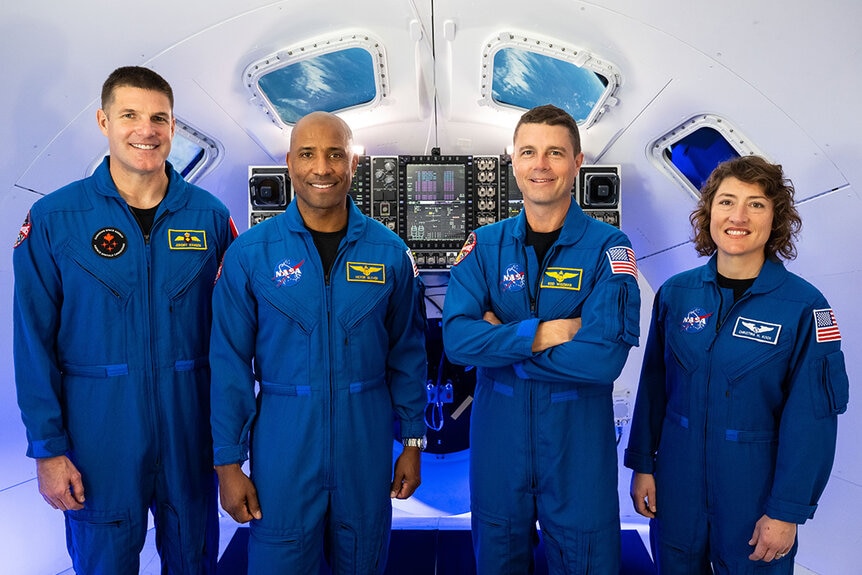Meet the Artemis II astronauts, set to take NASA's historic 2024 return trip around the Moon
The right stuff, indeed!

The pilot episode of SYFY’s The Ark (streaming now on Peacock!) is appropriately titled “Everyone Wanted to Be on This Ship.” See, the premise of The Ark is that humanity is in trouble and our only shot is to get to another planet around Proxima Centauri. Spaceships, unfortunately, only fit a limited crew so there must be a selection process. That’s true whether you’re trying to get on the last ship off a dying planet or trying to get into the history books as a member of a historic exploratory space mission.
For the time being at least, we don’t need to plan a species-saving Hail Mary into deep space, but we are sending astronauts back into the cosmos, first to the Moon, and then beyond. Following the success of Artemis I, NASA and international partners are preparing for the next phase of the program, which will carry humans around the Moon for the first time since Apollo.
RELATED: Splashdown: Orion returns safely from the Moon! What’s next for NASA’s ambitious Artemis program?
This morning, NASA introduced the world to the crew of Artemis II, the first crewed Artemis mission planned for launch in 2024. The broadcast began with Joe Acaba, the current chief of the Astronaut Office at Johnson Space Center (JSC) and Norman Knight, NASA’s Director of Flight Operations, taking to the stage. They were joined by the entire astronaut corps, from which the crew of Artemis II was chosen.
In that moment, the world was looking at the Artemis II crew, hidden like a Where’s Waldo among the gathered scientists, test pilots, and explorers. JSC’s center director Vanessa Wyche then came to the stage. She discussed the mission, which will travel 600,000 miles roundtrip. Along the way, the crew will kick the tires and test various systems in further preparation for the Artemis III lunar landing mission. Wyche took a moment to acknowledge Apollo alums and Canada’s Minister of Innovation, Science and Industry, François-Philippe Champagne, also in the audience.
Minister Champagne was in attendance because, in addition to Artemis II having the first woman and first person of color of any lunar mission, it also has the first Canadian astronaut. “We’ve learned that in order to go farther, we have to go together,” said Minister Champagne, in both English and French, during the broadcast. He also recounted a similar remark by United States President Joe Biden, during their last conversation, “Canada and the U.S. can do big things, because we do them together.”
It's in that spirit that the Canadian Space Agency is contributing to the Gateway lunar station with the Canada Arm III, as well as a vehicle to support lunar operations. Minister Champagne continued, “Canadians could not be more proud to have a Canadian astronaut who will travel to deep space as part of the Artemis II mission.”
After Champagne’s remarks, NASA Administrator Bill Nelson joined the stage alongside Deputy Administrator Pam Melroy and Associate Administrator Bob Cabana to reveal the four astronauts who will be taking the next flight around the Moon.
“It’s a message to the world. We choose to go back to the Moon, and then on to Mars, and we’re going to do it together. Because in the 21st century, NASA explores the cosmos with international partners. We will unlock new knowledge and understanding. We’ve always dreamed of what more is ahead. Why? Because it’s in our DNA. It’s who we are… this is humanity’s crew. May I introduce them to you all?” Nelson said.
CHRISTINA HAMMOCK KOCH – MISSION SPECIALIST
Koch (far right) is from Grand Rapids, Michigan where she grew up working on her family farm. She later earned degrees in Electrical Engineering and Physics, from North Carolina State University. Koch was selected to join the astronaut corps in 2013. Since then, she has spent more time in space than most.
Koch got started as an electrical engineer at the Goddard Space Flight Center (GSFC) where she contributed to several scientific instruments sent into space. As an astronaut, she was the flight engineer on the International Space Station for expeditions 59 through 61, where she set the record for longest single spaceflight by a woman with a total of 328 days in space. She was also a member of the first all-female spacewalk.
Koch will be one of the mission specialists of Artemis II, becoming the first woman to fly around the Moon, adding yet another first to an already impressive career.
JEREMY HANSEN – MISSION SPECIALIST
Hansen (far left) hails from London, Ontario where he grew up on a farm (get your parents to buy farms if you want to be an astronaut, kids). He joined the Royal Canadian Air Cadet Squadron at the age of 12. Four years later he’d earned a glider pilot’s wings and a private pilot’s license, at only 17.
He later earned degrees in Space Science and Physics from the Royal Military College of Canada. Hansen completed fighter pilot training and served in that capacity between 2004 and 2009, at which time he was selected for astronaut training.
He later participated in the ESA’s CAVES program, during which he lived underground for six days to simulate the isolation and close quarters of space. He was also a crewmember of NEEMO 19, during which he lived underwater in the Aquarius habitat for a week. Hansen led an astronaut class, training astronauts from both NASA and CSA and will now be one of the mission specialists for Artemis II. He will be the first Canadian astronaut to fly a lunar mission, reinforcing the sentiments from Minister Champagne and Director Nelson that we are stronger together than alone.
VICTOR GLOVER – PILOT
Glover (second from the left) was born in Pomona, California (not on a farm, for the record). He earned degrees in General Engineering, Flight Test Engineering, Systems Engineering, and Military Operational Art and Science from California Polytechnic, Air University, and the Naval Postgraduate School.
After years as a naval pilot, Glover was selected for a Legislative Fellowship and reported to the office of a U.S. Senator in Washington D.C., it was during that assignment that Glover was selected as an astronaut in 2013. After completing astronaut training, Glover flew the SpaceX Crew Dragon to the International Space Station. He was also the Flight Engineer for ISS Expedition 64. All in all, he has collected 168 days of spaceflight, including four spacewalks.
Glover was selected to be the pilot for Artemis II. He will be the first Black astronaut to fly around the Moon and pilot a lunar mission.
REID WISEMAN – COMMANDER
Wiseman (second from the right) is from Baltimore, Maryland. He earned degrees in Computer and Systems Engineering, as well as Certificate of Space Systems from Rensselaer Polytechnic Institute, Johnson Hopkins University, and the U.S. Naval Postgraduate School.
Following graduation from Rensselaer Polytechnic, Wiseman reported to the Fighter Squadron 101 as a Naval Aviator and was later selected to attend test pilot school. After graduating, he was assigned to Strike Fighter Squadron 103, where he flew an FA-18F Super Hornet, it was during that time that he was selected for astronaut training in 2009.
Reid was the Flight Engineer on the ISS for Expedition 41, a 165-day mission, and commanded the NEEMO 21 underwater training mission. He has also served as the Chief of the Astronaut Office, the position Acaba currently holds. Reid has been selected as the commander of Artemis II.
Artemis II is currently scheduled for launch in November 2024, with Artemis III following in late 2025. You can learn more about your Artemis II crew during a series of live interviews Tuesday, April 4, starting at 7:00 a.m. ET.
New episodes of The Ark air every Wednesday at 10 p.m. ET. on SYFY, then stream the next day on Peacock!

































